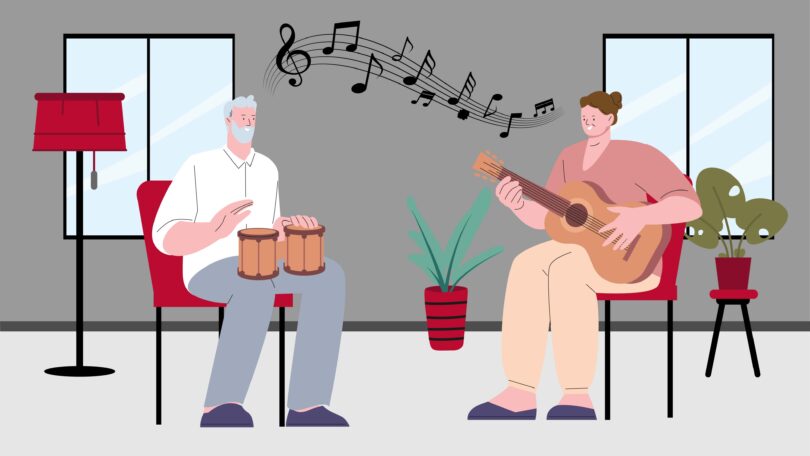Music and therapy. Anyone who has ever listened to Adele after a breakup or reminisced with their favorite 90s grunge tunes after a hard day will not be surprised to see these two words together.
For most of us, music is a source of entertainment, but we often benefit from its therapeutic properties. Music therapists highlight this phenomenon by combining the science of psychology, biology and neuroscience with the healing effects of music to address a patient’s physical and mental health.
Music therapy in practice
Receiving a dementia diagnosis can be incredibly difficult, both for the patient and their families. Jennifer Stull, an assistant professor of music therapy at the University of Georgia, says that as a dementia patient’s health declines, their sense of self also becomes unclear.
“Music is a stimulus that can provide familiarity in the midst of change,” says Stull.
As part of the clinical training portion of the university’s music therapy curriculum, Stull and her students lead music therapy groups with dementia patients. During the sessions, music is used to address various goals related to motor, memory, and social skills. To address these goals, patients may sing along to familiar songs, move to motivating music, and engage in conversation with other group members to become stronger physically and mentally.
“Our goal is not to teach them how to sing or how to play an instrument,” Stull said. “It’s learning how to use music to motivate them to exercise or help them keep their brain active by singing along to songs that they know. It’s asking how we can encourage them to socialize with their loved one. Sometimes listening to music together helps foster those relationships.”
Patients in the music therapy group use music as a tool to work towards different types of non-musical goals including:
- Motor,
- Communication,
- Cognitive,
- Social
- and Emotional.
The initial exercises can look as simple as filling in the blanks to a song. For example, a therapist might sing, “I’ve been working on the…” and encourage a patient to fill in the lyric. After the patient replies with the necessary “railroad,” Stull might ask, “Have you ever been on a train? Was that a long ride or a short ride? Was it a bumpy ride or a smooth ride?” Music therapists are trained to use music as a “foot in the door” to encourage reminiscing and elicit conversations.
What is the difference between music therapy and simply listening to music?
Rather than a set list at a concert or your Spotify playlist, music therapy with a trained professional is adaptable to the patient’s needs. Stull believes that the relational component between a patient and therapist is one of the most important parts of music therapy.
Music therapists learn a vast repertoire of musical genres, including hymns, country standards, classic rock, jazz, blues and pop. This allows them to provide live, patient-preferred music in sessions, which is especially important when trying to use music for memory recall or motivation for movement. Providing live music also allows the music therapist to adjust the speed and tempo of a song in the moment, based on a patient’s cognitive processing.
“We observe and interpret responses and then adjust what we’re doing based on what the patient needs. We never want to force the clients to fit the music. Instead, we want our music to fit the client,” says Stull.
Sarah Secrist, a fifth-year music therapy student at UGA’s Hugh Hodgson School of Music who participated in the program, has learned a lot about how important it is to properly observe patients.
“Even within the same diagnosis, people are experiencing a wide variety of symptoms and having to focus on different goals, so you really have to pay attention,” she said. “When I was working with someone’s social-based goals, I’d note whether or not they turn towards a sound source, if they make eye contact, how much they smile, and have to make judgements based off of that.”
What are the benefits of music therapy?
Music activates a variety of regions in the brain, including the section of your temporal lobes which is necessary for auditory processing, the primary motor cortex that controls a lot of the body’s movement, and the cerebellum, which affects balance, language processing, and memory.
“Music is processed all over the brain, so when we provide music, we’re actually activating areas that aren’t affected by the dementia. This is why even if someone can’t tell us what they had for dinner the night before, they can sing every word to their favorite song,” Stull said.
Music is entertainment, but it’s also a useful tool for people who are going through a difficult time after their dementia diagnosis. Multiple studies have shown that, in the hands of a professional, music can be beneficial to both patients and caregivers, from pain management to handling anxiety to improving communication.
“Not only are they getting the medical piece,” says Stull, “but they’re getting the social support and therapeutic services that we can provide. If our music therapy sessions can help one person have an easier time, I consider that a win for everyone.”







